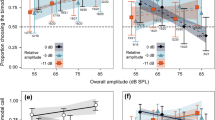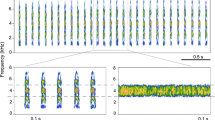Abstract
We investigated the natural dynamics in a sexual signal that combines different call components and explored the role of call complexity in sexual selection using a neotropical frog. Male túngara frogs, Physalaemus pustulosus, facultatively add up to seven short, multi-harmonic components (chucks) to the simple form of their calls (whines). Female túngara frogs are preferentially attracted to whines with chucks over whines without chucks, and males also call more in response to calls containing chucks. Because acoustic predators prefer complex calls, in the context of simple (no chucks) versus complex (any number of chucks) calls, the variably complex call appears to have evolved in response to the opposing selective forces of natural and sexual selection. There is no evidence, however, for the function of increasing the number of chucks within complex calls. We tested two aspects of increasing call complexity: natural patterns of use of call types in males and how both sexes respond to variation in multi-chuck calls. Males incrementally change call complexity by the addition or subtraction of a single chuck and usually do not produce more than two chucks. Variation in call complexity, for calls with at least one chuck, does not influence response calling in males or phonotaxis in females. Our results suggest that one reason for not increasing call complexity beyond a single chuck is the diminishing effectiveness on the responses of both sexes.




Similar content being viewed by others
References
Andersson MB (1994) Sexual selection. Princeton University Press, Princeton
Balsby TJS, Dabelsteen T (2002) Female behaviour affects male courtship in whitethroats, Sylvia communis: an interactive experiment using visual and acoustic cues. Anim Behav 63:251–257
Berglund A, Bisazza A, Pilastro A (1996) Armaments and ornaments: an evolutionary explanation of traits of dual utility. Biol J Lin Soc Lond 58:385–399
Bernal XE, Rand AS, Ryan MJ (2006) Acoustic preferences and localization performance of blood-sucking flies (Corethrella Coquillett) to túngara frog calls. Behav Ecol 17:709–715
Bernal XE, Page RA, Rand AS, Ryan MJ (2007a) Cues for eavesdroppers: do frog calls indicate prey density and quality? Am Nat 169:409–415
Bernal XE, Rand AS, Ryan MJ (2007b) Sexual differences in responses to non-conspecific advertisement calls: receiver permissiveness in male and female túngara frogs. Anim Behav 73:955–964
Bosch J, Rand AS, Ryan MJ (2000a) Acoustic competition in Physalaemus pustulosus, a differential response to calls of relative frequency. Ethology 106:865–871
Bosch J, Rand AS, Ryan MJ (2000b) Signal variation and call preferences for whine frequency in the túngara frog, Physalaemus pustulosus. Behav Ecol Sociobiol 49:62–66
Bosch J, Rand AS, Ryan MJ (2002) Response to variation in chuck frequency by male and female túngara frogs. Herpetologica 58:95–103
Bucher TL, Ryan MJ, Bartholomew GW (1982) Oxygen consumption during resting, calling and nest building in the frog Physalaemus pustulosus. Physiol Zool 55:10–22
Clark DL (1994) Sequence analysis of courtship behavior in the dimorphic jumping spider Maevia inclemens (Araneae, Salticidae). J Arachnol 22:94–107
Cohen J (1969) Statistical power analysis for the behavioral sciences. Academic Press Inc, New York
Endler JA (1978) A predator's view of animal color patterns. Evol Biol 11:319–364
Endler JA (1983) Natural and sexual selection on color patterns in poeciliid fishes. Env Biol Fishes 9:173–190
Gerhardt HC, Huber F (2002) Acoustic communication in insects and anurans. University of Chicago Press, Chicago
Gridi-Papp M, Rand AS, Ryan MJ (2006) Complex call production in the túngara frog. Nature 441:38
Grissom RJ, Kim JJ (2005) Effect Sizes for Research: A Broad Practical Approach. Lawrence Erlbaum, Mahwah, NJ
Kime NM, Burmeister SS, Ryan MJ (2004) Female preference for socially variable call characters in the cricket frog, Acris crepitans. Anim Behav 68:1391–1399
Morton ES (1982) Grading, discreteness, redundancy, and motivation-structural rules. In: Kroodsma DE, Miller MH (eds) Acoustic communication in birds. Academic Press, New York, pp 183–212
Narins PM, Lewis ER, McClelland BE (2000) Hyperextended call note repertoire of the endemic Madgascar treefrog Boophis madagascariensis (Rhacophoridae). J Zool 250:283–298
Patricelli GL, Uy AC, Borgia G (2004) Female signals enhance the efficiency of mate assessment in satin bowerbirds (Ptilonorhynchus violaceus). Behav Ecol 15:297–304
Pauly GB, Bernal XE, Rand AS, Ryan MJ (2006) The vocal sac increases call rate in the túngara frog, Physalaemus pustulosus. Physiol Biochem Zool 79:708–719
Rand AS, Ryan MJ (1981) The adaptive significance of a complex vocal repertoire in a neotropical frog. Z Tierpsychol 57:209–214
Rand AS, Ryan MJ, Wilczynski W (1992) Signal redundancy and receiver permissiveness in acoustic mate recognition by the túngara frog, Physalaemus pustulosus. Am Zool 32:15–17
Rosenthal R, Rosnow RL, Rubin DB (2000) Contrast and effect sizes in behavioral research: a correlational approach. Cambridge University Press, Cambridge
Ryan MJ (1985) The túngara frog: a study in sexual selection and communication. University of Chicago Press, Chicago
Ryan MJ (1990) Sensory systems, sexual selection, and sensory exploitation. Oxf Surv Evol Biol 7:157–195
Ryan MJ (1998) Receiver biases, sexual selection and the evolution of sex differences. Science 281:1999–2003
Ryan MJ, Keddy-Hector A (1992) Directional patterns of female mate choice and the role of sensory biases. Am Nat 139:S4–S35
Ryan MJ, Rand AS (1990) The sensory basis of sexual selection for complex calls in the túngara frog, Physalaemus pustulosus (sexual selection for sensory exploitation). Evolution 44:305–314
Ryan MJ, Rand AS (1995) Female responses to ancestral advertisement calls in túngara frogs. Science 269:390–392
Ryan MJ, Rand AS (1998) Evoked vocal responses in male túngara frogs: preexisting biases in male responses? Anim Behav 56:1509–1516
Ryan MJ, Rand AS (2003a) Sexual selection in female perceptual space: how female túngara frogs perceive and respond to complex population variation in acoustic mating signals. Evolution 57:2608–2618
Ryan MJ, Rand AS (2003b) Mate recognition in túngara frogs: a review of some studies of brain, behavior, and evolution. Acta Zool Sin 49:713–726
Ryan MJ, Tuttle MD, Rand AS (1982) Bat predation and sexual advertisement in a Neotropical anuran. Am Nat 119:136–139
Ryan MJ, Rand W, Hurd PL, Phelps SM, Rand AS (2003) Generalization in response to mate recognition signals. Am Nat 161:380–394
Schwartz JJ, Gerhardt HC (1998) The neuroethology of frequency preferences in the spring peeper. Anim Behav 56:55–69
Schwartz JJ, Wells KD (1984a) Interspecific acoustic interactions of the neotropical treefrog Hyla ebraccata. Behav Ecol Sociobiol 14:211–224
Schwartz JJ, Wells KD (1984b) Vocal behavior of the neotropical treefrog Hyla phlebodes. Herpetologica 40:452–463
Schwartz JJ, Wells KD (1985) Intra- and interspecific vocal behavior of the neotropical treefrog Hyla microcephala. Copeia 1985:27–38
Sokal RR, Rohlf FJ (1995) Biometry: the principles and practice of statistics in biological research. W.H. Freeman and Co, New York
Tuttle MD, Ryan MJ (1981) Bat predation and the evolution of frog vocalizations in the Neotropics. Science 214:677–678
Wollerman L, Wiley RH (2002) Background noise from a natural chorus alters female discrimination of male calls in a Neotropical frog. Anim Behav 66:15–22
Zar JH (1996) Biostatistical analysis, 3rd edn. Prentice Hall, New Jersey
Zuk M, Rotenberry JT, Tinghitella R (2006) Silent night: adaptive disappearance of a sexual signal in a parasitized population of field crickets. Biol Lett 2:512–524
Acknowledgments
We are grateful to the assistants that helped us record the calls, analyze the recordings, and perform female choice experiments. We are also thankful to J. Christensen-Dalsgaard and two anonymous reviewers whose comments greatly improved this work. The Smithsonian Tropical Research Institute provided critical logistic support. The Autoridad Nacional del Ambiente de Panama provided the permits to perform this research. The frogs were marked following the Guidelines for the Use of Live Amphibians and Reptiles in Field Research compiled by the American Society of Ichthyologists and Herpetologists (ASIH), the Herpetologists' League (HL), and the Society for the Study of Amphibians and Reptiles (SSAR), available at http://www.asih.org/pubs/herpcoll.html. This work was funded by grant IBN 0078150 from the National Science Foundation. The research presented complies with the current laws of the countries in which it was performed.
Author information
Authors and Affiliations
Corresponding author
Additional information
Communicated by J. Christensen-Dalsgaard
This is a posthumous publication for A. Stanley Rand
Rights and permissions
About this article
Cite this article
Bernal, X.E., Akre, K.L., Baugh, A.T. et al. Female and male behavioral response to advertisement calls of graded complexity in túngara frogs, Physalaemus pustulosus . Behav Ecol Sociobiol 63, 1269–1279 (2009). https://doi.org/10.1007/s00265-009-0795-5
Received:
Revised:
Accepted:
Published:
Issue Date:
DOI: https://doi.org/10.1007/s00265-009-0795-5




